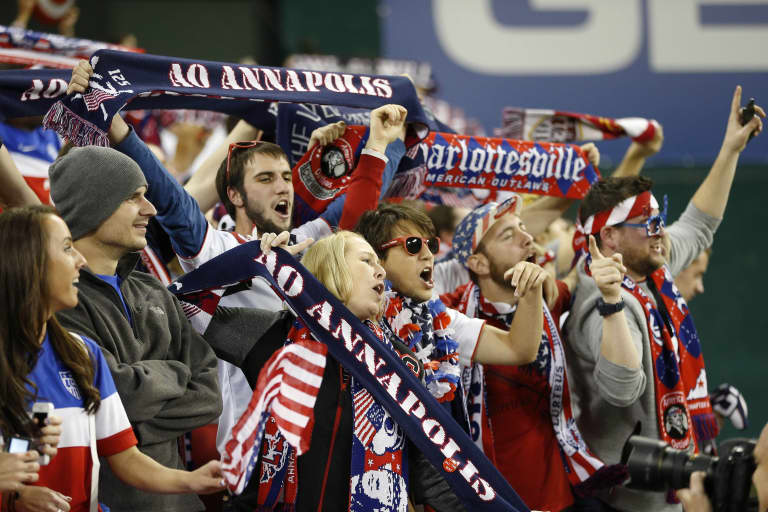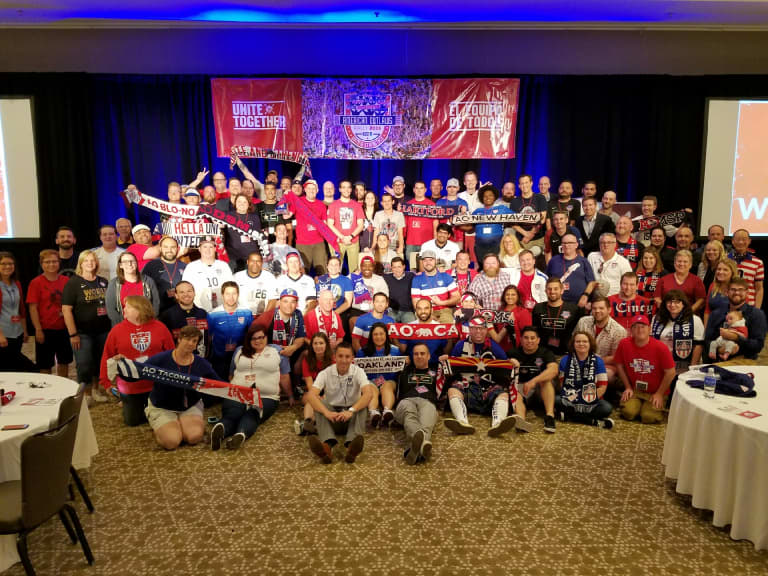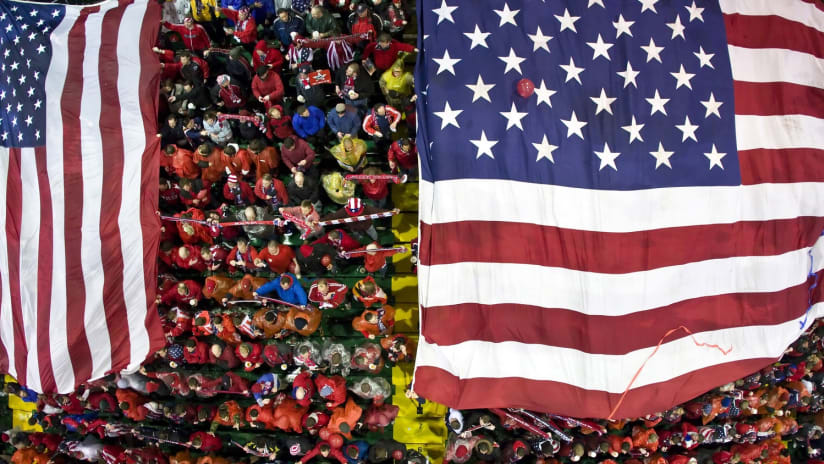FRISCO, Texas -- It’s a muggy evening on May 25 in the northern reaches of the Dallas-Fort Worth metroplex, and an outbreak of orange cones on every freeway leading to Toyota Stadium in Frisco is making traffic particularly unforgiving. But nearly 500 soccer fans have made their way to a series of red, white, and blue canopies in the stadium’s parking lot several hours prior to kickoff, ready to tailgate American Outlaws-style.
American Outlaws, with more than 30,000 dues-paying members and 187 active chapters backing the US men’s and women’s national teams, is the largest soccer supporters’ group in the nation. And thanks in part to ESPN’s ad campaign for the 2014 World Cup prominently featuring AO, it’s a visible organization that’s introduced the most casual tiers of soccer fans to the whole concept of supporters’ groups.
But it’s a group that owes a good deal to MLS supporters’ groups. The MLS-coined tagline “For Club and Country” absolutely applies across AO’s ranks. Throughout AO’s history, organizational knowledge and best practices have continued to pass freely between club fans and country fans in a collective effort to grow the love of soccer throughout the US.
And they turn up devotedly, even for matches that don’t figure largely into the team’s fortunes. This AO gathering in Frisco, for instance, sees the US facing Ecuador in a tune-up for the Copa America Centenario tournament starting on Friday.
The AO members come decked out in American colors, mostly in replica jerseys as likely to herald what state or AO Chapter they’re representing as a favorite player. Some take patriotism in a different direction, like one very tall fan who’s gone full Abraham Lincoln in a black suit and fake beard.
For this match, the entire AO section puts an exclamation point on a spirited national anthem rendition by throwing out red, white, and blue streamers in lieu of unfurling tifo. It’s fanfare that AO Dallas President Kasey Baker, also co-founder of FC Dallas supporters’ group Dallas Beer Guardians, notes was made possible by he and his crew “getting permission from US Soccer, and then going to every Party City in DFW.”
And it’s two fellow DBG members, co-founder Andrew Gerbosi (in a star-spangled jumpsuit) and new addition Tim Kelly (in a kilt), taking to boxes that serve as capo stands. They hoist bullhorns and lead the assembled AOs through familiar call-and-response chants.
This overlapping affiliation is typical. Some of the most active AO members have used their experience with MLS supporters’ groups to learn the essential nuts and bolts of creating the in-stadium experience, of tailgating, and communicating with front offices and stadium staffs.
AO has benefitted from the trial-and-error of 20-plus years of MLS fandom, dating back to the league’s earliest supporters’ group, to assemble a still-evolving set of best practices. In turn, they’ve worked to spread that knowledge by word of mouth, through online channels, and most recently, at an AO Rally in Austin last month, where more than 100 key members from across the nation convened.
And AO will also, naturally, descend on Santa Clara, Chicago, and Philadelphia for the USMNT’s Copa group matches. The atmosphere they bring will be, in large part, helped along by work that San Jose Earthquakes, Chicago Fire, and Philadelphia Union fans have been doing in their communities well before the Copa was announced.
Birth of the Outlaws
A decade ago, American Outlaws didn’t even exist. Founders-to-be Korey Donahoo and Justin Brunken were just two soccer fans from Lincoln, Nebraska, looking to connect to Sam’s Army—the US supporters’ group founded in 1994—as they made their way to the 2006 World Cup in Germany.
The day before the tournament’s first US match, Donahoo checked the Sam’s Army website hoping to find out the location of a pre-match tailgate. The site said information about that was “coming soon, check back later” —and then it kept on saying that as game time approached and eventually passed. Donahoo and Brunken returned from Germany pledging to create a more consistent, and better-communicated experience, for American fans traveling to matches.
They launched American Outlaws in 2007 by taking a bus full of 60 fans in matching shirts from Lincoln to Chicago for a friendly against Brazil. They tailgated. They brandished a banner Donahoo remembers being too small for fans in the stadium to read. They had such a good time that they wanted to do it again.
So they spread the word about the new group, taking to American soccer’s online forums and journeying to the 2007 MLS Cup final in D.C. The game featured the Houston Dynamo and New England Revolution, and is best known in supporters’ lore as the national coming-out party for the Philadelphia Union’s Sons of Ben. And thanks to a supporters’ summit the night before the match, the 2007 Cup also helped raise American Outlaws’ national profile.
“We had people there calling us the next generation of US soccer fans,” Donahoo remembers. “We were nervous going there, deciding to do this other thing from what Sam’s Army was doing. But when people cheered us, it seemed to us that this would be liked. It was a key moment for us.”
They connected with D.C. United’s Screaming Eagles early on, learning what they could from that well-established supporters’ group. When Screaming Eagles, New York’s Empire Supporters’ Club, and the first Revs supporters’ were coalescing in the mid-1990s, they often connected and learned through their involvement in Sam’s Army. Those seasoned supporters’ groups were now, in turn, sharing knowledge with the new US group.
“A lot of people from MLS supporters’ groups came to us,” Brunken recalls. “We had a lot of conversations. We started learning different chants from different cities.”
Brunken notes that the group has grown so gradually, and in such a grassroots fashion, that it’s hard to pin down specific milestones like AO’s first tifo. Their focus, in the first few years and even to this day, has been to create a consistent platform allowing fans to come in to contribute. They also prioritize communicating clearly, so fans know where to go the night before a match to congregate with fellow fans, when and where to tailgate and march into the stadium en masse, and what to chant once they’re in their section.

AO members from different local chapters gather to support the USWNT during a 2015 WWC qualifier at RFK Stadium. Photo via USA Today Sports Images
Local Color
That network of support can turn out to be massive – like the 7,500 AO members who descended on Columbus for the World Cup-clinching Hex match against Mexico in 2013, or the 2,000-plus who crossed into Canada for last year’s Women’s World Cup triumph.
But even early in a World Cup cycle, when the US is playing friendlies and lower-ranked CONCACAF teams, AO looks to create the best possible experience for its members, thereby creating the best possible home-field advantage for the team. And that means – rather than being a singular, monolithic organization – they aim to be one that stays attuned to the local cultures where games are hosted.
Donahoo and Brunken emphasize that the 187 chapters should “be together, not the same.” When a US game is first announced by US Soccer, AO reaches out to the chapter or chapters near the host stadium to coordinate.
“They live there, and they know the culture,” says Donahoo of the local chapters. “We’ve planned a million of these events, but they know the terrain.” That extends beyond logistics to knowing how to involve fans and inspire them, and in more than one case, to attract new members.
Donald Wine II, currently both AO DC president and a Screaming Eagles field team member, is a lifelong soccer fan who first saw Screaming Eagles in action in 2007 (followed by AO in 2008). He wanted to be part of the excitement, and joined both groups. His dual membership has come in handy for RFK Stadium-hosted US games, which features some of the trickiest acoustics of any American stadium.
“In MAPFRE Stadium, for example, you don’t need to be on the field to get a chant going; it can flow out from the middle of the crowd,” Wine explains. “But in RFK, if you try to start something in row 12, you might not be able to hear it in row eight. There, you need your capos to face the crowd, bounce sound off the wall, and use the reverb so it can be heard on the field.”

American Outlaws members gathered at a May 2016 rally in Austin, Texas. Photo by Will Leverett
Details, Details
For AO, creating the optimal in-stadium experience starts well before a match—both local and national AO reps meet with stadium officials in advance of a match to work out details. In cases like Copa America Centenario and the 2015 Gold Cup, in which some host stadiums are more familiar with NFL rather than MLS games, it can require education on the banners, drums, capos, and 90 minutes of standing that a supporters’ group brings.
For the planning around the USMNT’s June 11 game in Philadelphia against Paraguay (7 pm ET, FS1), Sons of Ben members Julian Brown and Ryan Bross will be among the AO Philly contingent welcoming fans to their hometown. The game, however, will be in a less-familiar stadium, Lincoln Financial Field, not the Talen Energy Stadium that they and the Union know as home.
Brown, currently president of AO Philly, joined both supporters’ groups in 2011 and previously served on the Sons of Ben’s board before the AO Philly post and fatherhood consumed his time. Brown’s particularly happy that Philadelphia’s getting a Copa group match. The 2015 Gold Cup final took place in Philadelphia, and the hopes of 1,500 AOs were dashed when the US fell in the semifinal and had to make due with a dour third-place game. He’s gone as far as to characterizing the Paraguay match as “redemption.”
“I’ve had a chance to learn how to capo from some of the best of the league,” Brown notes of his time in Sons of Ben. “One of the things that I learned that applies to both being in both the Sons of Ben and AO is how important it is to be on the same page and have solid internal communication. In my time on the SoB board, communication was a well-oiled machine, and with AO, we're talking every day.”
Bross, who specializes in tifo for both groups, is accustomed to working on all stages of a tifo – designing, sewing, sketching out the design one 39” by 39” square at a time, and even traveling to secure the best fabric.
But the June 11 game will reveal his first-ever tifo displayed at “the Linc.” And there’s another notable first for this tifo, a portion of it was created at the Austin AO Rally, so members could see how it was produced, and even get in some first-hand painting experience.
“We’re trying to take away the scare factor for you,” explained Dan Wiersema, from Austin, who handles communications for American Outlaws and was led the rally’s “Tifo 101” session. (He’s also an occasional contributor to MLSsoccer.com.) “The little mistakes you notice up close won’t show up on TV.”
Blemishes may not show on screen, but AO tifo is often detailed and involved, especially when experienced tifo-makers get behind a concept. Crystal Cuadra-Cutler, an AO San Jose founder and a member of San Jose Earthquakes supporters group the Faultline, recalls just one such undertaking. It was for the USMNT’s 2014 World Cup send-off match against Azerbaijan in San Francisco’s Candlestick Park.
She drew on experience from both AO and her MLS support work to create two-stick, 3’ x 4’ tifo depicting the entire US squad. The undertaking started two months prior to the match with initial sketches and actual construction beginning a month before the match. They ended up showcasing 21 of the 23 squad members, only leaving out the backup goalkeepers.
“They are a lot of time and hard work,” Cuadra-Cutler says, “but it’s worth it in the end to see them go up on game day.”
“The detail in [DeAndre] Yedlin’s hair, though,” recalls AO Oakland’s Heather Hendricks, who also worked on the project. “There were a lot of four-letter words said over that one.”
For the recent USMNT match against Guatemala in Columbus, AO collaborated with #TIFOSWEAT, Columbus Crew SC’s dedicated tifo crew. Together both groups executed an impressive tifo, showcasing the synergy possible between AOs and experienced local supporters who are accustomed to the US coming to town.
While AO and MLS supporters’ groups continue to draw from each other in existing markets, the AO influence is spreading to cities that are just gearing up for new club teams. In Atlanta, for example, three different supporters’ groups are readying for the debut of new MLS team Atlanta United FC next year.
AO Atlanta president Kelly Carter notes that Atlanta has a core of knowledgeable soccer fans, but the region, as a whole, is “just now getting into learning how to soccer.” She was initially drawn to AO because she wanted to get behind a top-level team, but the closest MLS team at the time was six hours away in D.C.
Curtis Jenkins of Footie Mob, a newly emerging Atlanta supporters’ group that aims to draw a spirited, kid-friendly crowd, has looked to AO to answer basic questions on merchandising and watch parties at bars.
Sam Veal of Resurgence, which aims to be a more traditional, full-90 supporters’ group, notes that AO’s helped to galvanize soccer fans in Atlanta. Veal notes that a lot of people in Atlanta were originally born somewhere else, but gravitated to the city and boast a civic pride which will translate well to MLS.
Some AO chapters, meanwhile, count among their numbers fans of multiple MLS teams, and despite the “for club and country” slogan, AO chapter leaders have to be mindful of how those club passions play out. AO Tacoma’s Janine Mann, who has both Sounders and Timbers fan in her chapter, likes to remind members gathering for AO events, “We’re all red, white, and blue today.”
Consistency is Key
Ultimately, the biggest challenge for AO remains keeping the support for the US men and women’s teams consistent and strong, even though the schedule takes them from city to city. Wiersema told me last year (for my forthcoming book on MLS and supporters’ group culture) that many MLS supporters’ groups succeed because they’re able to cultivate that consistency:
"Look at the Timbers Army. They have 34 games a year in Major League Soccer. They get 17 at home, in the North End, with the same people mostly, every time, with the same capos, who they probably recognize by first name. They have tifo committees, there are chants developed organically and inorganically, and they can practice them. A chant that may not get any traction in game one could be sung by 2,000 people by mid-season or game 17."
“I Believe,” the chant that’s come to epitomize the 2014 World Cup campaign, feels a bit to AO veterans like the hit song that a band’s grown a little tired of playing live. Wiersema thinks that it’s a fantastic chant to use at the start of a match to voice optimism, and at the recent US friendly against Ecuador in Frisco, that’s exactly how it was used, making just a single appearance in the second half beyond that.
In a feel-good keynote address at the AO Rally, Men in Blazers co-host Roger Bennett talked about the unique way in which American soccer fans exist vis a vis the rest of the world, defined in part by hosting the ’94 World Cup, but also by the work that American Outlaws are doing to foster love for the US teams.
For Bennett, the rising popularity of soccer in the United States is a complicated amalgam that includes the explosive rise of the Internet, the FIFA video game series, and the increased availability of global soccer (including a robust MLS) on American TV. But within that equation, he credits American Outlaws with proliferating what he terms a “collective joyous memory-making” that bonds soccer fans who experience a shared love for a team.
That wonderful phrase is ultimately why Brunken and Donahoo are devoting themselves to AO.
They, like many of their fellow AO members, have an MLS allegiance as ardent Sporting Kansas City fans, though they don’t get to venture to home games as often as they might like. Especially now, as they’re already preparing for the impending 2018 and 2019 World Cups, during which they believe their group might top 50,000 members.
And yet, they remain humble at the growth of American Outlaws, whose rapid explosion continues to mirror that of the sport itself in the US.
“We’re really just trying to facilitate what’s happening,” Donahoo says. “They’re out there writing the story. We’re just trying to make it easier for them to do that.”













